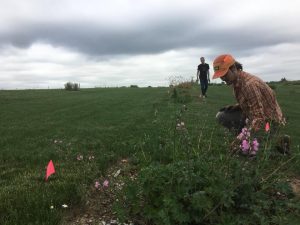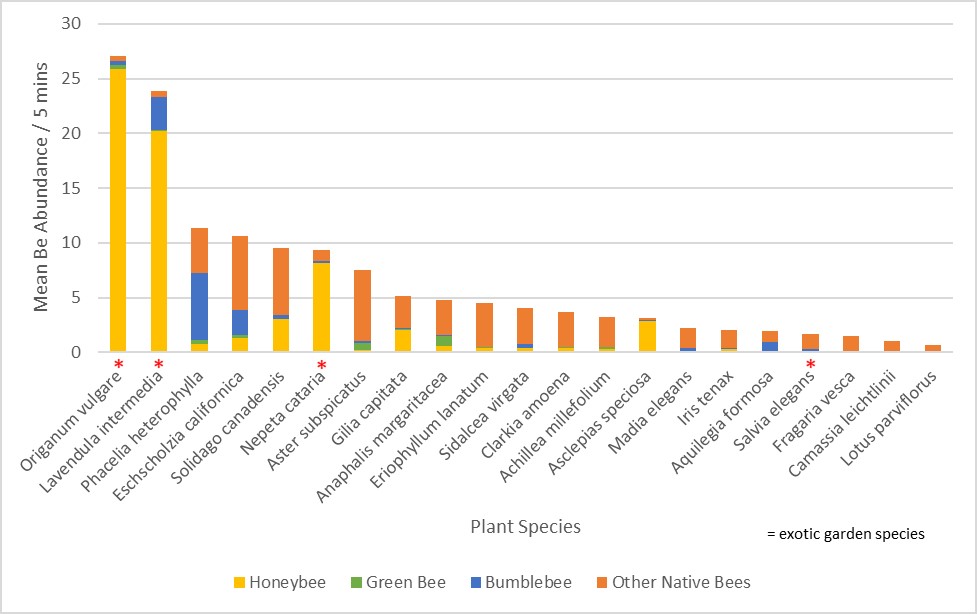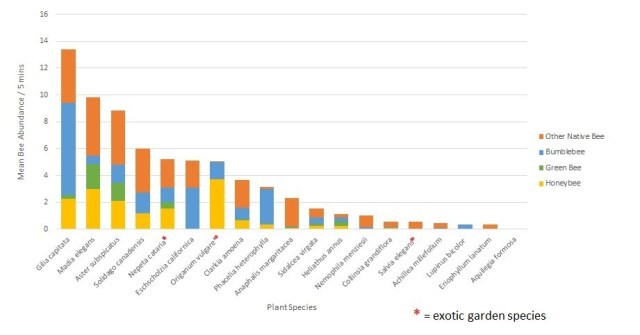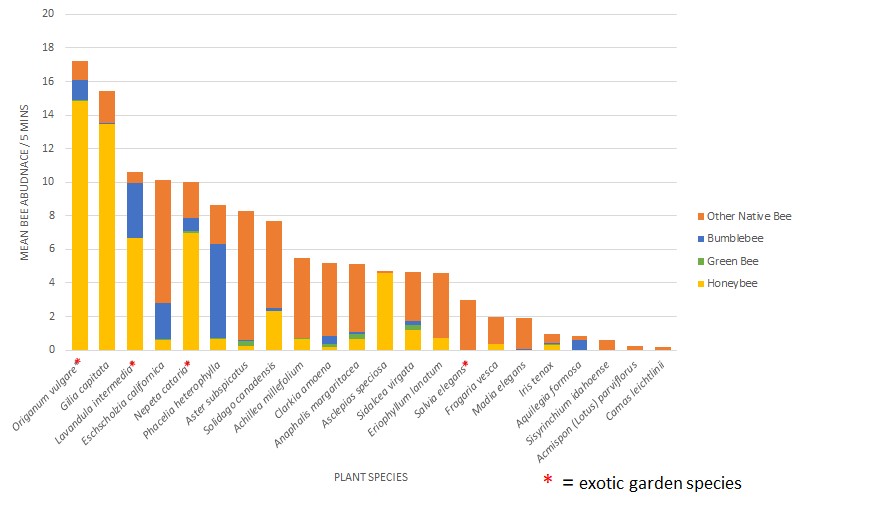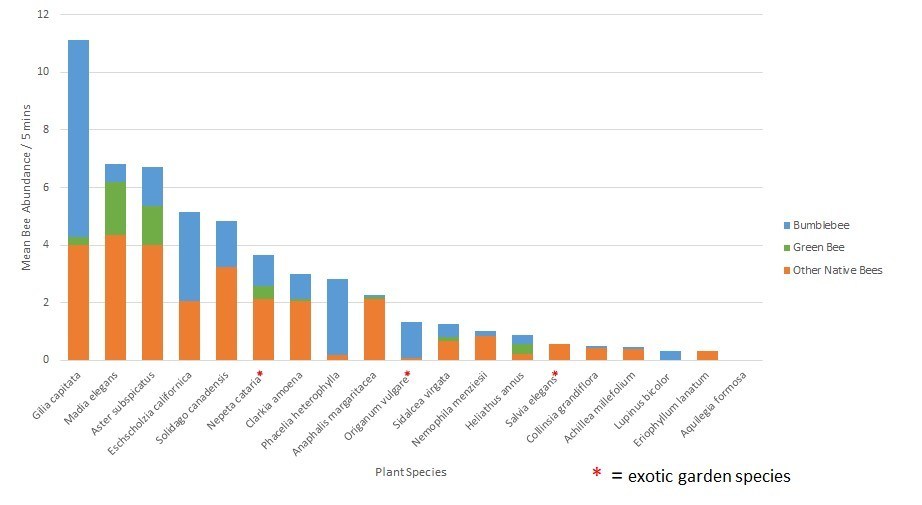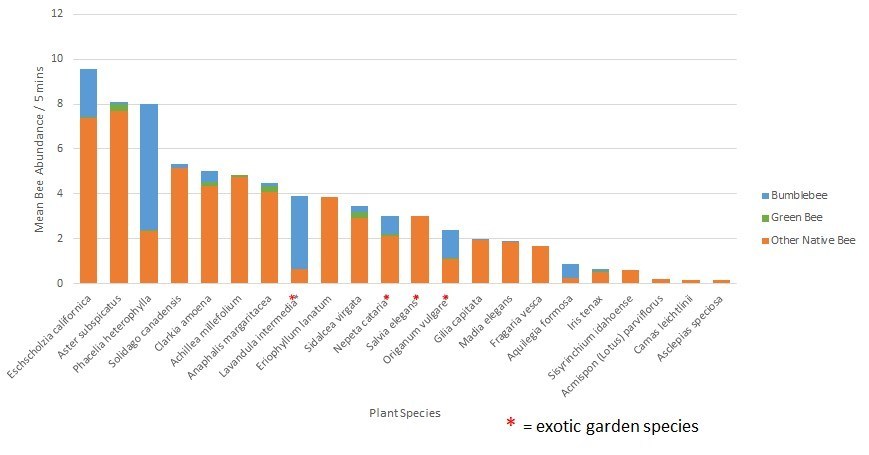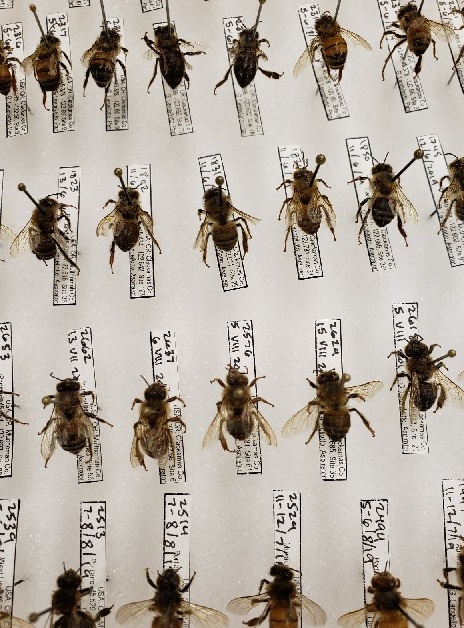Every June – August, from 2017-2019, we collected bees from 25 Portland area gardens. As I start to build out a Bee Guide for Portland Gardens, I wanted to highlight some of the notable bees that we collected. We are still waiting for our 2019 bees to be identified. The details, below, are for bees that were collected in 2017 and 2018 and identified by Sarah Kornbluth (2017) or Gabe Foote (2018).
We collected five species of bee in the genus Megachile:
- Megachile rotundata (2 females and 1 male)
- Megachile angelarum (8 females and 5 males)
- Megachile perihirta (1 female)
- Megachile fidelis (3 females)
- Megachile centuncularis (1 female)
Worldwide, Megachile bees are extremely diverse: an estimated 1,400 species of Megachile bees can be found, globally and an estimated 140 species of Megachile can be found in the United States. These bees are in the Family Megachilidae, which includes the leafcutting (e.g. Megachile species), mason (e.g .Osmia species), and wool carder bees (e.g. Anthidium species). In the family Megachilidae, females carry pollen on their abdomen.
In this post, I wanted to cover Megachile fidelis, Megachile perihirta, and Megachile angelarum.
| Bee Species | Origin | Diet | Sociality | Nesting |
| Megachile angelarum | Native | Generalist (Prefers Lavandula, Perovskia, Vitex) | Solitary | Cavity |
| Megachile perihirta | Native | Generalist | Solitary | Soil |
| Megachile fidelis | Native | Generalist (Prefers Asters) | Solitary | Cavity |
Megachile angelarum was the most common bee in this genus that we collected from Portland area gardens.

Diet: Although this species has been collected from a broad array of floral hosts (see list from Discover Life), Frankie et al. (2014) note that this species prefers lavenders (Lavendula), Russian sage (Perovskia), and chaste tree (Vitex).
Sociality: This species is solitary, which means that each individual female builds her own nest, collects nectar and pollen to provision her young, and lays her own eggs. In bees with advanced social structures, such as honey bees, the workers collect nectar and pollen to feed the young, and the queen lays the eggs. Solitary bees die soon after they build their nest, load nest cells with pollen and nectar, lay their eggs, and seal the nest cell shut. Many solitary bees may nest in close proximity to each other. Thus, solitary bee doesn’t mean loner bee; it means that the female does all of the work on her own, without cooperation or collaboration from other bees in her species.
Nesting: Megachile angelarum nests in cavities. Rather than cutting leaves, females collect resins and gums to partition nest cells. Since this bee does not cut leaves, it lacks teeth on its mandibles, unlike other bees in the genus. The bee has been found in drilled pine wood (10cm deep holes, 0.5 cm in diameter; Dicks et al. 2010). Other studies have found this species in nest blocks with a 3/16th hole size (Galasetti 2017).
Appearance: Like many bees in this genus, it is a robust-sized bee, with females typically spanning 10-11 mm in length and males a bit smaller, at 8-9 mm in length. The lack of teeth and cutting edges on the mandibles can be helpful for identification.

Notes: Across 2017-2018, we collected this bee from seven different Portland area gardens, or nearly 1/3 of our sampled gardens. Megachile angelarum is likely parasitized by another bee, Stelis laticincta. Stelis laticincta is a social parasite, or cleptoparasite of other bees. What this means is that Stelis laticincta invades the nest of another bee, and lay their own eggs, just as cuckoo birds do with other birds. Once the Stelis laticincta eggs hatch, the larvae kill the Megachile angelarum larvae, and eat the pollen and nectar provisions that have been provided by the Megachile angelarum mother.
We collected a single Stelis laticincta in 2017-2018, and it came from a garden where we collected four Megachile angelarum specimens. Having a healthy Megachile angelarum population increases your chances of having more bee species, by supporting cleptoparasites, such as Stelis laticincta.
Megachile perihirta is commonly known as the Western leafcutter bee.
Diet: This bee is a generalist, and will collect nectar and pollen from many different types of flowering plants.
Sociality: Solitary (see notes for M. angelarum).
Nesting: Unlike many Megachile bees, this species does not nest in cavities, but instead digs shallow nests in the soil (Frankie et al. 2014, page 102). I had thought that all bees in the genus Megachile were cavity nesters. (Actually, I thought that all bees in the family Megachilidae were cavity nesters). But, Eickworth et al. (1981) report that soil excavation was widespread in the family Megachilidae and in the genus Megachile.
Appearance: This was the largest Megachile species we collected. Females typically spanning 13-14 mm in length and males span 12-13 mm in length.

I am soooooo sad that we didn’t collect a male of this species! The males have enlarged forelegs, covered with hairs (photos of the males can be found here and here), which the MALES USE TO COVER THE FEMALES EYES DURING MATING!!!! Biologists suggest that this helps to keep females calm and receptive, during mating (Frankie et al. 2014, page 103).
Notes: We only collected a single specimen of this bee. It came from our smallest garden (1,800 square feet in size), in an industrial area of Northeast Portland. And seriously: how cool is it to have a bee species where the mating ritual includes the male covering the females eyes with his super-hairy forearms!!!??
Megachile fidelis
Diet: Frankie et al. (2014) note that this species seems to prefer plants in the Asteraceae, including Aster, Erigeron, Rudbekia, Cosmos, and Helenium). Hurd et al. (1980) note that this species is commonly collected from sunflowers (Helianthus).
Sociality: Solitary (see notes for M. angelarum).
Nesting: This is a cavity nesting bee that tends to occupy larger holes (0.65 to 0.80 cm in diameter (Barthell et al. 1998). Unlike Megachile angelarum, which does not cut leaves or petals to line their nest cells, UC Davis has a great photo of a female Megachile fidelis carrying a piece of Clarkia petal. In his native bee research, Aaron Anderson would regularly find bees cutting neat discs from Clarkia flowers. I wonder, now, if collecting petal discs from Clarkia flowers is characteristic of M. fidelis.
Appearance: This species is another robust-sized bee. Females typically spanning 11-13 mm in length and males span 10-12 mm in length.

Once again, I am beyond bummed that we didn’t collect a male of this species! Males of this species also have enlarged forelegs covered with long hairs, although not as pronounced as in male M. perihirta. Once again, biologists suspect that the males use their hairy forearms to cover the females eyes during mating (Frankie et al. 2014, page 103).
Notes: We collected one specimen from a 0.2 acre, flower-filled garden that is adjacent to a golf course in Canby. The other two specimens were collected from a 0.1 acre, flower-filled garden in Northeast Portland.




